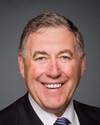The numbers show that about 42% of our revenues are from international sales.
If I could, in following up to your observation, I'd just make a point. It's one that I think we, as Canadians, should collectively be quite proud of.
A number of years ago, researchers at the Mint developed a new technology to make coins less expensively, as I explained earlier. We had no idea how that was going to pay off to the extent that it has paid off.
Right now, it costs the United States government, the United States Mint, 8.3¢ to make one nickel. It costs 3.3¢ more than the face value of the coin. The Royal Canadian Mint can make a nickel for under 2.5¢. There is still seigniorage available to the Canadian government and the Canadian taxpayer as a result of our capacity to make coins more cheaply.
We have a patent on that technology. We're quite prepared to talk to the U.S. Mint, should they ever get authority from the Congress to change the content of their coins and use our technology, although we would charge them a pretty nickel.



